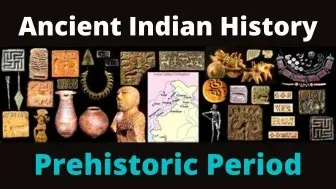TABLE OF CONTENTS
☉ Beginning of Indian Civilization and Culture
✩ Prehistoric Period
✩ Proto-Historic Period
✩ Historical Period
☉ Prehistoric Cultures
✩ Paleolithic Period
☞ Lower Paleolithic
☞ Middle Paleolithic
☞ Upper Paleolithic
☉ Mesolithic Period
☉ Neolithic Period
☉ Chalcolithic Period
☉ Beginning of Indian Civilization and Culture
The history of Indian civilization and culture has started from the Stone Age. The Stone Age is also considered the earliest period of human civilization. On the basis of the means of information of history, the historical period is mainly divided into three parts-
1. Prehistoric Period
2. Proto-historic Period
3. Historical Period
✩ Prehistoric Period
The art of writing was not developed in the 'prehistoric period'. The sources of information for that period are archaeological evidence such as stone tools.
✩ Proto-Historic Period
The art of writing had developed in the 'proto-historic period' but is still unreadable. The period of Indus Valley Civilization is termed as 'Proto-historic period'.
✩ Historical Period
'Historical period' That period of history, whose written evidence is available and whose meaning is clear, is called historical period, such as the period after the Mahajanapadas.
☉ Prehistoric Cultures
The prehistoric period is also called the 'Stone Age' because all the archaeological evidence of that period is made of stone. It is divided into three periods-
1. Paleolithic Period
2. Mesolithic Period
3. Neolithic Period
✩ Paleolithic Period
The earliest period of the Stone Age is known as the Paleolithic period. For the first time in India, in 1863 AD, a scholar Robert Bruce Foot obtained stone-made evidence from Pallavaram (Madras). In 1935 AD, D. Terra and Peterson obtained important stone tools from the Shivalik hills. The Palaeolithic Period is divided into three parts-
1. Lower Paleolithic
2. Middler Paleolithic
3. Upper Paleolithic
☞ Lower Paleolithic
Stone tools of this period have been found in Sohan river valley (Punjab province of Pakistan), Singrauli valley (UP), Chotanagpur, Narmada valley and all over India (except Sindh and Kerala). The main tools- scales, gandasa, Khandaka tool, handcuffs and chatikashma. The bone remains of Homoerectus have been found in the Narmada Valley. This period is also known as the Sohan culture, the Chapar-Chapping Pebul culture and the Hadax culture. Apart from tools, fossils of elephant, wild buffalo, hippopotamus etc. have also been found during this period. Humans of this period hunted animals and lived like animals in caves. A human skull has also been found in the Narmada valley from a village named Hathnier, it is about one and a half lakh years old. This is the oldest human remains ever found in India.
☞ Middle Paleolithic
Evidence of the existence of humans has been found in almost all the provinces of India except Sindh (Pakistan), Kerala and Nepal during this period. Main sites- Nevasa (Maharashtra), Didwana (Rajasthan), Bhimbetka, Narmada valley, Purulia (West Bengal), Tungabhadra river valley. The main tools of this period were borers, scrapers, drills. Evidence of people of this period has been found from more than 200 rocky caves of Bhimbetka. This was the era of the Northdarthal humans.
☞ Upper Paleolithic
The main tools of this period were takshini, plank, scraper. Habitat- Renigunta and Kurnool (Andhra Pradesh), Solapur and Bijapur. Bone tools - ornamented sticks, harpoon, pointed needles. Remnants of pure vane industry have been found from Belan Ghati. From Renigunta a huge collection of faces and signs has been found. Bone tools have been found from Kurnool. Green and dark red colors have been used in the painting of caves of Bhimbetka.
☉ Mesolithic Period
Main sites- Bagor, Panchpadra Valley and Sanjat (Rajasthan), Langhnaj (Gujarat), Akkhaj, Balmana, Vindhya and Satpura areas, Adamgarh, Bhimbetka, Birbhanpur (W. Bengal), Sangankal of Karnataka and Sarai Nahar of U.P. Rai, Lekhhima, Morhana mountain. Main tools Microlith tools such as blades, crescent tools, single edge tools, triangles, crescent and trapezoidal tools, pointed tools. The people of this period were familiar with the funeral procession. Dog bones have also been found along with human bones. Rock shelters of the Middle Stone Age have been found in the Mahadev hills in Pachmarhi.
☉ Neolithic Period
Main places- Adamgarh, Chirod (Bihar), Balochistan, U.P. of Belan Valley, Vrajdham and Gufkral (Kashmir), Mehrgarh, Pt. Bengal, Peninsular India, Kotdiji etc. The main tools are polished stone tools, stone axes, small stone tools and bone tools. Main features- Start of agriculture, animal husbandry, making pottery, weaving cloth, cooking food with fire, man became permanent resident, huts made of cane and bamboo started, construction of boat. The places Chirand and Senar are famous for bone tools. Evidence of rice from Belanghati (U.P.), earliest evidence of agriculture from Mehrgarh (7000 BC), evidence of earliest animal husbandry from Adamgarh and Bagor (5000 BC). The residents of Burzahom used pottery.
☉ Chalcolithic Period
The first metal used in human life was copper (about five thousand BC). The main Chalcolithic cultures were as follows - Ahar and Gilund (Banas Valley of Rajasthan, S.C.), Kayatha (M.P.), Gilud (Ahmednagar, Maharashtra), Malwa culture Malwa pottery was found to be the best among all Chalcolithic cultures. Went . Main site- P. Bengal, Podu Rajar, Dibi and Birbhum, Sewar in Mahishadal Vihar, Chirand, Taradih and U.P. In Raviradih and Nauhan.
The people of this culture used small tools and weapons of copper and stone, such as panels. Panels were the main sites of Jorwe culture - Jorwe, Nevasa, Daimabad, Chandoli, Sonegaon, Inamgaon, Prakash and Nasik. The old name of 'Ahad' was 'Tamwavati' (meaning copper place). Here dark red colored pots were used. Pucca bricks were not used. People lived in stone houses. Sothi culture (Rajasthan) was spread in the areas of Ghaggar valley.
Evidence of burial of dead bodies has been found in stone rocks in Kerala. The. Evidence of Chalco-Stone Age and Iron Age settlements have been found from Brahmagiri, Sanganakallu, Maski, Piklihal, Hallur etc. of India.

Comments
Post a Comment
Please do not enter any spam link in the comment box.